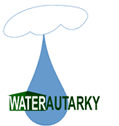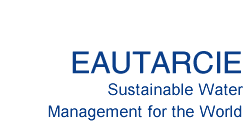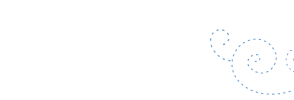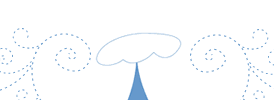
The considerations explained herein about the legal aspects of water utilization must be regarded as a concerned citizen's manifesto on water policies.
The following pages will be useful to water policy advisors and decision-makers, particularly in many parts of Europe and North America, as well as in those regions of the world that may be tempted to reproduce unsustainable supply and sanitation techniques. Arid and semi-arid regions of the world are traditionally and naturally more sensitive to the significance of rainwater harvesting, and it is to be hoped that official policies in these regions will be more in line with this concern: therefore, the considerations herein may (or may not) apply to those regions.
Managing one’s water as per the EAUTARCIE concept is more than a simple technical option: it is a social choice expressing a highly political standpoint. As such, the system’s prime quality is to conduce to a school of responsible management.
To visualize the general schematic of a PLUVALOR system, click here![]() .
.
To visualize the general schematic of a Complete TRAISELECT system,
click here![]() .
.
The text within this page was first published in French on www.eautarcie.com:
in 2003
The original text has since been adapted and was first published in English on this page at www.eautarcie.org:
2010-04-20
Last update: 2012-01-08


Managing One's Own Water
Official Water Management Policies
Official public policies are largely influenced by experts working for water distribution companies. Official views usually propound centralized management of all water resources, to be entrusted to water distribution company technicians. The reasoning behind this is that it would better safeguard water quality and safety through regular monitoring and controls. In this system, the user becomes a consumer who delegates his responsibilities to others, with the following well-known consequences:
- The implementation of centralized systems having an environmental life-cycle performance that is far from positive (see chapter on The Failings of Sanitary Engineering);
- Technically complex arrangements at exceedingly high costs for individuals and society;
- Water becomes a negotiable commodity that is mainly profitable for multinationals. These companies will thus have a vested interest in techniques that perpetuate or aggravate water problems.
In the best of cases, official policies have, up to now, only recognized rainwater harvesting for:
- External taps for watering the garden and exterior washing;
- Flush toilets and sometimes even laundry, always after the water’s «disinfection»;
- Policies strongly advise against the use of rainwater for personal hygiene and food and drink.
Conventional views perpetuate the practice of consuming water that has been made «potable» (at high cost) for all household uses. The official approach, even in this sense, is incoherent. The public is advised to save water, all the while that rainwater harvesting is «overlooked».
Sustainable Water Management – A Social Choice
Managing one’s wastewater and rainwater as per EAUTARCIE principles is more than a simple choice or technical option: it’s also a social choice, a highly political gesture (see chapters on Water supply policies and Wastewater treatment policies). From this point of view, the EAUTARCIE concept is conducive to a school of responsible management.
Conditioned by media, authorities and some environmental advocacy groups, consumers tend to misconstrue modern comfort as irresponsibility. A home that is equipped with EAUTARCIE’s systems is barely less convenient than a standard home. Just as renewable energy use doesn’t signify a return to the oil lamp, EAUTARCIE is not synonymous of lesser hygiene, water shortages and noxious latrines.
Yet it remains, that with EAUTARCIE, you become your own water supplier, with all the responsibility that goes with it. In spite of appearances, when you open your faucet, you can no longer rely on continuous water supply flowing «from the source», like with centralized distribution. At each moment, you must be conscious that you are managing a limited resource, even if it is perfectly renewable. In this sense, «saving water» takes on a broader perspective. There will be bounteous rainy periods followed by scarcer ones. A correctly sized cistern will ensure maximum harvest of this resource, yet it remains everyone’s responsibility to adapt their daily consumption to the limitations of their set-up. When you have a large roof with matching cistern, the usually recommended «water saving» measures loose all significance.
During one of my conferences in France, a municipal elected official expressed concern that «harvesting rainwater in a cistern removes this water from the water cycle». The official was alluding to reduced water infiltration into the soil due to its diversion, from catchment on impervious surfaces. The extension of impervious surfaces is often denounced as an impediment to replenishing the water table. In some German states, they go so far as to tax surfaces that are made impervious. This constitutes a position that is scientifically incoherent, socially unjust, and not environmentally friendly. As to the EAUTARCIE approach to rational rainwater use and wastewater treatment, if harvested rainwater is diverted to permeable ground surfaces after use, this water is in fact restored to ground water reserves. If, on the other hand, it is diverted to city sewers, it will simply replace the city water that one would have otherwise used. Moreover, sensitive souls concerned about concrete and asphalt surfaces don’t realize that city sewers actually drain river-sized volumes of water towards rivers. And about 80% of this water was actually taken up in underground water reserves. Of utmost concern is the fact that policies promote the expansion of areas served by centralized sewerage networks, whereby enormous quantities of water are conveyed straight into waterways.
When sanitation engineers come to realize the environmental wastage caused by centralized sewerage and treatment will be the day we take a giant step towards worldwide sustainable water management.
With EAUTARCIE, a home’s impact on water reserves is nil: water harvested from the sky is restored to the soil after use, pollution-free.
The Tasks Related to EAUTARCIE
Rainwater Harvesting
Managing the contents of one’s cistern obviously involves equipment maintenance. For example, the cistern, gutters and water filters need to be cleaned. Such maintenance doesn’t require special skills and can be undertaken by the vast majority of the population. One can also hire help or contract the work. The savings that could be generated by abandoning centralized systems could finance this maintenance [1].
Proponents of centralized water supply and wastewater treatment assert that this industry creates jobs, while individual endeavours such as the EAUTARCIE concept destroy jobs. Yet, when you delve into the field of rainwater harvesting and individual wastewater treatment systems, you discover the existence of a large number of related businesses that provide gratifying jobs. The difference lies in how the consumer’s money is spent: to support local small business instead of enriching water multinationals.
For certain tasks, there are tools available to help us out. Managing the cistern’s contents can be aided with the use of a water tank level gauge where the gauge display will be installed close to the cistern, in a basement or under the kitchen sink. This simple and low-cost apparatus indicates the water level ![]() within the cistern.
within the cistern.
Monitoring drinking water quality is a must. When filters are clogged, the water flow will diminish. A simple cleaning of the filter cartridges is sufficient to correct this situation.
Water that is filtered through a saturated activated carbon filter will take on a slight odour and cement taste. That means it’s time to change the activated carbon filter cartridge. Commercial filters have a filtering capacity of about 20 to 25 m³ of water. This is why I recommend placing a water meter directly upstream from the microfiltration system. Generally speaking, you must follow filter manufacturers’ recommendations on scheduled maintenance and cleaning.
If drinking water is obtained from a reverse osmosis unit, water quality monitoring will require the use of a portable![]() conductance meter available on the market for about 20 €. You don’t need a lab-quality instrument, only a simple tester. Measuring the conductivity upstream and downstream from the filtering unit will indicate the right moment to change the osmosis unit’s membrane.
conductance meter available on the market for about 20 €. You don’t need a lab-quality instrument, only a simple tester. Measuring the conductivity upstream and downstream from the filtering unit will indicate the right moment to change the osmosis unit’s membrane.
Primary filters and activated carbon must be replaced annually.
Selective Grey Water Treatment
When treating grey water to its fullest extent by including a decorative pond (see Complete TRAISELECT system), you must be aware that this set-up needs maintenance: regularly removing excess algae, cutting back aquatic plants annually, cleaning the pump of whatever small fountain or waterfall you may have. Yet, pond maintenance doesn’t require more time and work than what you would put in for a flower garden of similar size. Nevertheless, when you simply infiltrate treated grey water issuing from an anaerobic bioreactor (see Basic TRAISELECT system), there is absolutely no maintenance involved.
Dry Toilets
For some, carrying dry toilet effluent from the BLT to the compost bin can be a major drawback, while others have no problem accepting this chore. Dumping the toilet receptacle contents on the compost pile, covering the heap with litter and washing the receptacle require only a few minutes work. They become routine domestic chores like dishwashing, laundering, housecleaning and mowing the lawn.
Building up a compost heap also requires a few hours of work. Yet this work is most often already done by those who compost their kitchen and garden waste.
The «Risks» of EAUTARCIE
Proponents of centralized systems, most often employees or technicians working for water distribution and sanitation companies, insist on the danger of EAUTARCIE’s systems. They put forth the following arguments:
- The lack of regular quality control would put the consumer at risk;
- Correct maintenance of a rainwater harvesting system would require an understanding and know-how that only a small part of the population can be expected to acquire;
- Rainwater is polluted; it can even contain large quantities of pesticides, heavy metals like zinc and lead; it lacks minerals, is acid and corrosive;
- Rainwater harvesting involves substantial costs that are only accessible to the more affluent;
- Generalized rainwater use would lead to an increase in the price of water;
- The overall environmental life-cycle assessment of whole-house rainwater reuse would be less favourable than for centralized distribution;
- Handling human excrement from dry toilets would put the users at risk.
The rebuttals to these arguments can be found within this website’s pages. I will however add a few additional thoughts and relevant data.
The «Dangers» of Domestic Rainwater Reuse
Water supply technicians and bureaucrats detract rainwater reuse by spreading false images![]() of this technique. Or again they propose incorrect techniques
of this technique. Or again they propose incorrect techniques![]() . It’s interesting to note that some mains water suppliers and regional authorities distil the same misinformation. We mustn’t forget that the technical and scientific information spread by private industry technicians aims to promote the sale of a commodity, and in so doing, must be perceived as information of a commercial nature. As to the misinformation spread by public utilities or «non-profit» mains water supply representatives, one cannot exclude influence peddling from the private business sector, and even a public sector concern to maintain its fiscal revenues. In France for example, you often hear of the «dangers» of domestic rainwater reuse.
. It’s interesting to note that some mains water suppliers and regional authorities distil the same misinformation. We mustn’t forget that the technical and scientific information spread by private industry technicians aims to promote the sale of a commodity, and in so doing, must be perceived as information of a commercial nature. As to the misinformation spread by public utilities or «non-profit» mains water supply representatives, one cannot exclude influence peddling from the private business sector, and even a public sector concern to maintain its fiscal revenues. In France for example, you often hear of the «dangers» of domestic rainwater reuse.
To those rainwater detractors who lobby to maintain the existence of mains water supply monopolies, we say:
«The sun shines for all. Must we close the blinds to protect candlemakers’ business?» [2]
In reference to the writings of French political economist Frédéric Bastiat who in 1846, published a satirical work«Pétition des marchands de chandelles» (Candlemakers’ petition) in his «Sophismes économiques» (Economic Sophisms), about unfair competition from the sun
Instead of discoursing on the dangers of domestic rainwater reuse, it would be more «scientific» to verify, objectively, the real dangers, in the field. To do so, you need only realize an epidemiological study to compare the health of two control populations, whose only dissimilarity would lie in their water supply.
In a study carried out by Belgium’s Walloon chapter of the World Wildlife Fund (WWF) and AQUAWAL (an association in Wallonia representing the key players from local water supply and wastewater sanitation industries and water regulating bodies), the number of people who have been drinking harvested rainwater for years in Belgium can be estimated at more than 100 000, while 750 000 use it for their personal hygiene. Is this too little to be considered a social phenomenon? Yet, such figures are substantial enough to discredit talk on the dangers of rainwater consumption. Up to now, no rainwater-related health problem has ever arisen. This doesn’t mean there is no risk. However, users of mains water supply are exposed to no lesser risk. Read more on this subject on the Chlorine and UV irradiation page. In addition, what about the terrorist risks of someone putting toxic substances in water towers?
The (French and Belgian) assertions that rainwater has a negative environmental life-cycle performance are based on a study that was carried out in Switzerland [3] in which were compared the retrieval and centralized gravity distribution of pure alpine-source water (needing practically no treatment) to conventional rainwater harvesting systems. To generalize the results of a study based on such exceptional conditions is abusive.
Ref: «Analyse du cycle d’approvisionnement en eau et récupération d’eau de pluie» (Rainwater harvesting and water supply life-cycle analysis): final report of «Cycleaupe» project, O. Jolliet et al, Laboratoire de gestion des écosystèmes, numéro UM-147-F, 2002.
In reality, most centralized water distribution installations require pumping from a reservoir, a well or surface water. To be distributed, it requires sophisticated and relatively expensive treatments. Its energy consumption is generally accepted at about an average value of one kilowatt-hour of electricity per cubic meter of water distributed. Comparatively, the energy required to pump a cubic meter from a cistern is a mere fraction of this.
This being said, it is quite obvious that a comparative environmental life-cycle assessment needs to be done. Throughout my long career at the Université de Mons-Hainaut, I sought in vain to get financing for such a study, including an epidemiological study on eventual health risks of whole-house rainwater reuse. Neither the Walloon Region, nor the European Community, nor other bodies were willing to invest in this matter.
On water quality, the arguments put forth by industry technicians remain theoretical: they are concerned with the presence of bacteria in a rainwater cistern. Yet, it is quite simple to eliminate bacteria from drinking water. Moreover, they compare their mains water to rainwater falling on a roof. It is stunning to observe that acknowledged scientists dare to compare water quality of mains water supply to water harvested in a cistern. Such a comparison is totally inadequate. Water in a cistern is a raw material that needs to be treated before use, just like watercourses, wells and reservoirs provide water as a raw material for water distribution companies. Water from theses sources is no more drinkable than a rainwater cistern’s water.
A scientifically unbiased approach must compare mains water to rainwater that has been collected in a cistern and than properly filtered by microfiltration or reverse osmosis. Such a comparison isn’t to mains water’s advantage. Centralized water distribution corporations rarely apply such advanced techniques for water treatment.
Highlighting excessive pesticide content that may occur in a few showers [4] does not take into account a set of realities:
- • Managing a cistern usually involves water from an average twenty rainfalls, of which maybe one may be contaminated. Thus in most cases, there is a dilution effect;
- The pesticide levels that were measured in the study, slightly more than one tenth of a microgram (0,1 µg/litre), can only present a potential risk in case of ingestion as drinking water – if even then. Such levels border on official potable water standards. At these levels, the ever-present activated carbon component of any decent filtering system required to make water potable is a guaranty of quality [5]. Those who fear the presence of such substances in their bath water can even place an activated carbon filter upstream of their non-potable water supply network;
- You mustn’t lose sight of the fact that a centralized water distribution network’s primary source is ultimately the same rainwater that an individual will harvest from his roof. Yet the individual’s harvested rainwater will not have seeped through farmland, laden with pesticides and herbicides in much greater quantities than what could eventually be found in a rainfall. It will not have absorbed nitrate pollution of mainly agricultural origin. It will not have been drawn from rivers into which are discharged domestic and industrial wastewaters.
For further reading: «Dichloorvos en andere bestrijdingsmiddelen in het regenwater in Vlaanderen – Interimrapport»: period 02/97 – 12/97 (Dichlorvos and other pesticides in rainwater in Flanders – interim report), as well as «Bestrijdingsmiddelen in het regenwater in Vlaanderen – Rapport over 1998» (Pesticides in rainwater in Flanders – Report 1998). Contact: Hoofdt Afdeling Informatie du VVM, A Van De Maelestraat, 96, B-9320 Erembodegem, tel.: 0036.(0)53.72.62.11.
To eliminate pesticides, mains water distribution companies use – if ever – the same technique. In reality, these companies rarely use activated carbon filtration.
Asserting that rainwater is acid, corrosive and mineral-poor does not stand up to serious scientific scrutiny, when considering rainwater that is stored in a concrete or masonry cistern. During my conferences, a regional bureaucrat criticized me for recommending the consumption of «unsafe mineral-poor» water to the public. Using his logic, I suggested he demand the shutdown of Spa Monopole (Belgium), a company that sells Spa Reine bottled water containing 50% less mineral salts than cistern water. Likewise, Mont Roucous (France) bottled water contains 6 times less. Yet, health food specialists consider both these very pure waters as the best on the market (free publicity!). Potable water that comes from rain, collected in concrete cisterns and filtered by reverse osmosis has a mineral composition that is very close to that of Mont Roucous. Water aficionados can hardly tell the difference between the two. Rainwater that has been made potable with a microfiltration unit more closely resembles Spa Reine water. In both cases, rainwater made potable in this way costs 8 times less per litre, considering amortization costs for the initial set-up.
Potential heavy metal content in rainwater has been the subject of many studies. Here again, you must compare equitably. Instead of comparing a cistern’s water to mains water produced at the distribution facility, you must rather compare it to the water at the consumer’s tap. In another of my conferences, the director of a water distribution company asserted that they had never measured such high heavy metal levels as those I had measured at the city of Mons’ mains water supply, casting doubt on my competence or my scientific integrity. I did in fact measure 25 times more zinc in Mons’ city water that in a string of cisterns. You can cast doubt on one researcher’s findings, but less so when a team of researchers confirm similar findings in a study carried out over many years, for an official State laboratory. Indeed, Belgium’s CSTC laboratory (Centre Scientifique et Technique de la Construction or «Scientific and Technical Centre for Construction») measured up to 11 900 µg/l of zinc in city water at the consumer’s faucet, and less that 130 µg/l in rainwater cisterns. Report findings were similar in the case of copper [6].
Ref.: K. De Cuyper et K. Dinneg, (laboratoires de CSTC),«La qualité de l’eau à la sortie du robinet» (Water quality at the faucet). Tribune de l’eau, n°268/2, March-April 1994, pages 35-42.
| Parameter | City Water | Rainwater |
| Temperature [°C] | 46 | 46 |
| pH | 7,3 | 6,3 |
| Total hardness [°F] | 31 | 6,3 |
| Copper [µg/l] | 1,4 - 1.230 | 112 - 288 |
| Zinc [µg/l] | 0 - 11.900 | 80 -130 |
| Chrome [µg/l] | 0 - 400 | 0 - 20 |
| Nickel [µg/l] | 0,50 | 3 -20 |
| Total germs [CFU/ml] | ||
| 22° after 24 h | 0,7 | 0,7 |
| 37° after 24 h | 62 | 62 |
| 22° after 72 h | > 300 | > 300 |
| 37° after 48 h | < 300 | < 300 |
The «Danger» of Composting Dry Toilet Effluent
As to the «potential danger» that may represent the «handling of human excrement» from a dry toilet like the BLT, epidemiological studies have been carried out by Dr D’Hoore of the University Catholique de Louvain, under the auspices of the Walloon Region [7]. The study’s findings were conclusive: BLT users did not present greater health problems related to fecal contamination than the rest of the population. It was even observed that BLT users were healthier than those using flush toilets. If the findings had been reversed, you can be sure that BLT’s would outright have been declared unsafe.




